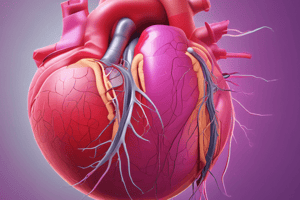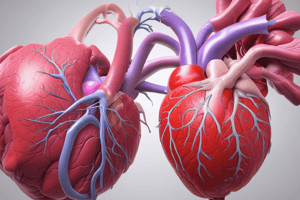Podcast
Questions and Answers
Match the type of pericarditis with its characteristic features:
Match the type of pericarditis with its characteristic features:
Suppurative pericarditis = Thickened pericardium with foul-smelling pus Fibrinous pericarditis = Yellow fibrin deposits on the pericardium Traumatic reticulopericarditis = Foreign body-induced infection in the pericardial sac Chronic pericarditis = Potentially a long-term inflammatory response
Match the microscopic findings with their corresponding pericarditis:
Match the microscopic findings with their corresponding pericarditis:
Fibrinous pericarditis = Eosinophilic threads of fibrin and neutrophils Suppurative pericarditis = Infiltration of pus and bacteria Traumatic reticulopericarditis = Presence of foreign bodies in the tissue Chronic pericarditis = Fibrous tissue accumulation over time
Match the process of pathogenesis with the event it describes:
Match the process of pathogenesis with the event it describes:
Penetration by foreign bodies = Accumulates in the reticulum Infection introduction = Happens after penetration of the diaphragm Inflammatory response = Results in pus accumulation Thickening of the pericardium = Leads to a shaggy appearance
Match the following conditions with their descriptions:
Match the following conditions with their descriptions:
Match the gross findings with their disease context:
Match the gross findings with their disease context:
Match the following nutrients with their associated diseases:
Match the following nutrients with their associated diseases:
Match the pericarditis type with the example provided:
Match the pericarditis type with the example provided:
Match the following symptoms with the conditions they relate to:
Match the following symptoms with the conditions they relate to:
Match the following definitions to the diseases:
Match the following definitions to the diseases:
Match the following descriptions to their related concepts:
Match the following descriptions to their related concepts:
Match the following causes of infections with their related organisms:
Match the following causes of infections with their related organisms:
Match the sequels to endocarditis with their affected locations:
Match the sequels to endocarditis with their affected locations:
Match the following conditions with their potential outcomes or complications:
Match the following conditions with their potential outcomes or complications:
Match the following medical terms with their definitions:
Match the following medical terms with their definitions:
Match the conditions associated with horses to their respective types:
Match the conditions associated with horses to their respective types:
Match the following medical terms with their definitions:
Match the following medical terms with their definitions:
Match the following anatomical structures with their functions:
Match the following anatomical structures with their functions:
Match the following associated conditions with their primary characteristics:
Match the following associated conditions with their primary characteristics:
Match the following components with their relevance to the cardiovascular system:
Match the following components with their relevance to the cardiovascular system:
Match the following terms with their related organs or systems:
Match the following terms with their related organs or systems:
Match the following symptoms of Foot and Mouth Disease (FMD) with their descriptions:
Match the following symptoms of Foot and Mouth Disease (FMD) with their descriptions:
Match the following serotypes of Foot and Mouth Disease with their corresponding designations:
Match the following serotypes of Foot and Mouth Disease with their corresponding designations:
Match the following typical gross findings of FMD with their characteristics:
Match the following typical gross findings of FMD with their characteristics:
Match the following animals commonly affected by FMD with their classifications:
Match the following animals commonly affected by FMD with their classifications:
Match the following clinical findings of FMD with their implications:
Match the following clinical findings of FMD with their implications:
Match the heart failure type with its associated characteristics:
Match the heart failure type with its associated characteristics:
Match the descriptive term with its corresponding finding in heart failure:
Match the descriptive term with its corresponding finding in heart failure:
Match the findings within the lungs to their related conditions:
Match the findings within the lungs to their related conditions:
Match the condition with its specific pathological feature:
Match the condition with its specific pathological feature:
Match the terms related to heart failure with their definitions:
Match the terms related to heart failure with their definitions:
Flashcards are hidden until you start studying
Study Notes
Septicemia & Cl. Novyi
- Pericarditis caused by Cl. Novyi results in yellow fibrin deposits on the pericardium.
- The parietal and visceral layers of the pericardium adhere, resembling "butter and bread."
- Microscopically, the fibrin appears as eosinophilic threads with neutrophils.
Suppurative Pericarditis
- Suppurative pericarditis can occur in cattle due to traumatic reticulopericarditis.
- Foreign bodies like nails and wire accumulate in the reticulum, penetrating the reticular wall and diaphragm, leading to infection in the pericardial sac.
- Grossly, the pericardial sac thickens with white rough masses, having a shaggy appearance, filled with white to grey, thick, foul-smelling pus.
Myocardial Degeneration & Necrosis
- Myocardial degeneration and necrosis can occur in various conditions.
- Foot and Mouth Disease (FMD) affects young farm animals causing degeneration.
- White Muscle Disease, caused by deficiencies in Vitamin E and Selenium, also affects young farm animals.
- Grossly, affected regions in the heart appear yellow or white.
- Migrating Strongylus vulguris larvae in horses and Streptococcus equi in horses can cause myocardial degeneration.
Endocarditis Sequelae
- Endocarditis frequently leads to thromboembolisms.
- Thromboembolisms can affect organs like the brain, kidneys, spleen, and joints.
Ulcerative Endocarditis
- Ulcerative endocarditis is characterized by ulcers and mineralization.
- It can be associated with uremia in dogs.
Lymphangitis & Lymphontitis
- Lymphangitis and lymphontitis involve inflammation of lymph vessels.
Right Atrium
- The right atrium can be affected by infections affecting the heart.
- The right atrium may develop a brown coloration in cases of infections or diseases.
Foot and Mouth Disease (FMD)
- FMD is a highly contagious viral disease, affecting cloven-hoofed animals including cattle, sheep, goats, and swine.
- The virus belongs to the Aphthovirus genus of the Picornaviridae family.
- Seven serotypes of FMD virus exist: A, O, C, Asia-1, SAT-1, SAT-2, and SAT-3.
Clinical Findings of FMD
- Salivation, lameness, fever, and decreased milk production are common clinical signs.
- Hyperemia in the mouth and coronary bands may form vesicles.
- Sudden death can occur in young animals due to myocarditis.
Gross Findings of FMD
- Hyperemia is observed in the oral mucosa, udder, and feet, particularly along the coronary band.
- Vesicles and ulcers form on the dorsal aspect of the tongue and coronary band.
- In young animals, myocardial necrosis may be evident, resulting in grey/yellow streaks ("tiger heart").
Left-Sided Heart Failure
- Pulmonary venous congestion: Fluid backs up in the pulmonary veins due to the heart's inability to pump blood effectively.
- Pulmonary edema: Fluid leaks from the congested pulmonary capillaries into the alveoli, causing shortness of breath.
- Intra-alveolar hemorrhage: Red blood cells leak into the alveoli, potentially leading to coughing up blood.
- Red cell phagocytized by alveolar macrophages: The immune cells in the lungs engulf the red blood cells.
- Iron pigment in alveolar macrophages: The broken-down hemoglobin from the red blood cells leaves behind iron pigment, giving the macrophages a brown appearance, known as "Heart Failure Cells".
Right-Sided Heart Failure
- Systemic venous and portal hypertension: The heart's inability to pump blood effectively leads to increased pressure in the veins of the body, including the portal vein that drains the intestines.
- Chronic passive congestion: This means that blood pools in the tissues due to impaired drainage, leading to a build-up of fluid.
- Edema and ascites: Fluid accumulates in the tissues, causing swelling (edema) and fluid buildup in the abdomen (ascites).
- Chronic passive congestion of liver: The liver, with its many veins, becomes congested with blood, leading to impaired liver function.
- "Nutmeg liver": The liver's appearance resembles a nutmeg due to the alternating dark red (congested) and pale (normal) areas.
Studying That Suits You
Use AI to generate personalized quizzes and flashcards to suit your learning preferences.




